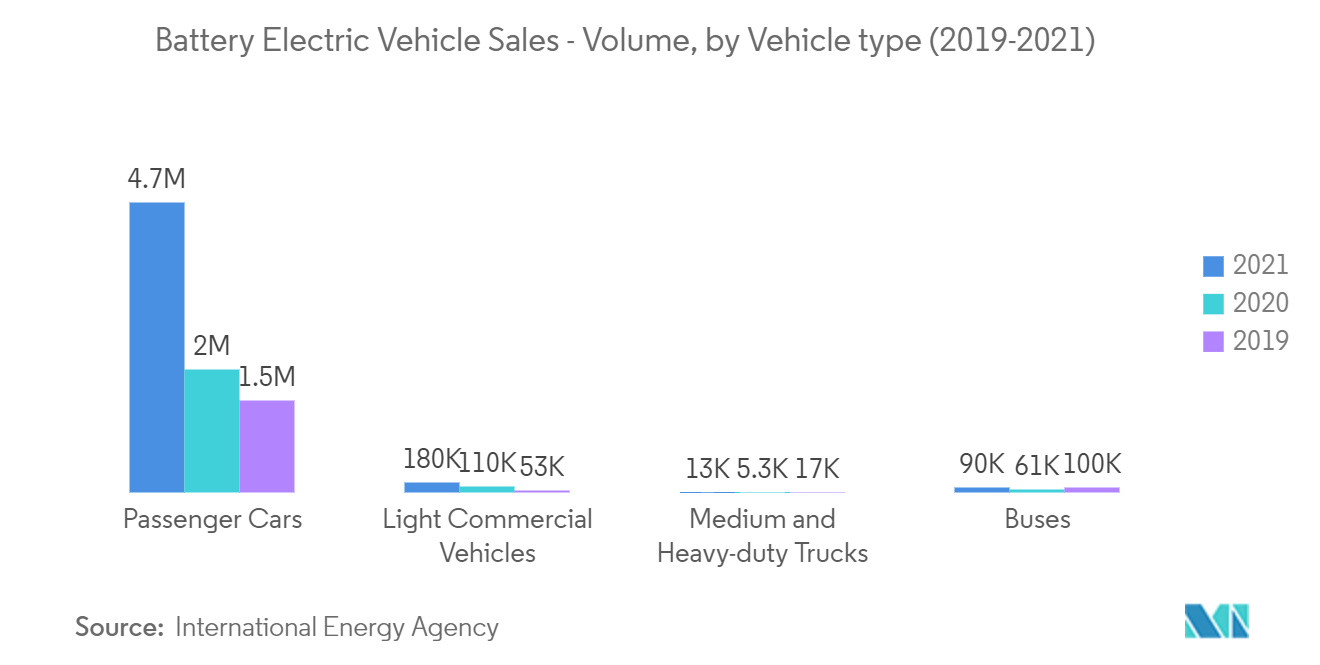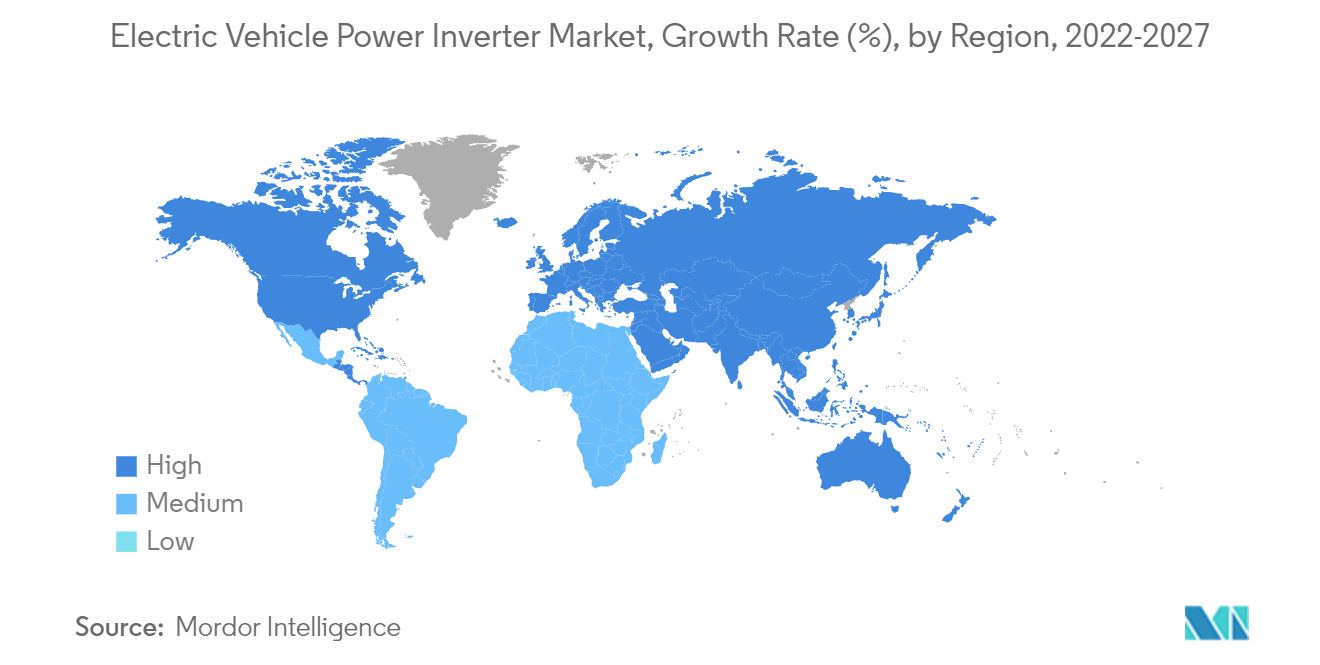Market Trends of Electric Vehicle Power Inverter Industry
This section covers the major market trends shaping the Electric Vehicle Power Inverter Market according to our research experts:
Growing Sales of Electric Vehicles
Electric vehicles have become an integral part of the automotive industry, and they represent a pathway toward achieving energy efficiency, along with reduced emissions of pollutants and other greenhouse gases. The increasing environmental concerns, coupled with favorable government initiatives, are some of the major factors driving the market growth.
Global battery electric vehicle sales were marked at 3.5 million units in 2021, which was significantly higher compared to sales figures in 2020. The movement to accelerate the adoption of light-duty passenger electric cars (EVs) and phase out traditional vehicles with internal combustion engines is gaining traction around the world. The increase in average fuel prices reflects the fact that Europe has a higher share of new electric car registrations than other parts of the world. Hence, mass adoption of electric vehicles, owing to rising fuel prices, is expected to proliferate business globally.
Rising government investment in the development of charging infrastructure across the globe is likely to promote the sale of electric vehicles. For instance,
- In October 2022, the German government invested Euro 6.3 Billion (USD 6.1 Billion) to increase the number of charging stations across the country.
- In September 2022, Japanese leasing company Orix announced the installation of electric vehicle charging stations across the country. The company will build around 50,000 charging stations by 2025 in partnership with Ubiden.
Moreover, the high cost associated with batteries has necessitated the improvement of inverters and other power electronics, along with improving the performance of vehicles. For instance,
Shifting customer preference towards electric vehicles is an evident sign for future decarbonization and simultaneously decisive for charging stations, although penetration of EVs is subjected to various attributes, including consumer behavior, infrastructure, and certain regional clusters. An increase in electric vehicle sales will proportionally fuel the demand for charging stations. Prominent players in the market have diagnosed the pinpoint of consumer sentiment and thus are focusing on catering to it by offering fast-charging technologies across the country.
Though change has not resulted in a slump in IC engine vehicle sales, it created a promising market for electric vehicles in the present and future. The above trend has propelled some of the automakers to increase their expenditure on R&D in electric vehicles and associated components, like power inverters, while others have started focusing on launching new products to capture the market share, eventually pushing the demand in the market.

Asia-Pacific is leading the Electric Vehicle Power Inverter Market
Asia-Pacific is leading the electric vehicle power inverter market, followed by Europe and North America, respectively. The sale of electric vehicles in China is growing at a rapid pace. Despite a global downturn in auto sales due to a shortage of semiconductor supply caused by COVID-19 pandemic, electric vehicle sales in China increased by 154 percent last year, as more people chose cleaner vehicles. Electric vehicle (EV) manufacturers sold a total of 3.3 million units in China in 2021, up from 1.3 million in 2020 and 1.2 million in 2019.
The government of India has undertaken multiple initiatives to promote the manufacturing and adoption of electric vehicles in India to reduce emissions pertaining to international conventions and develop e-mobility in the wake of rapid urbanization. With the increasing sales of electric vehicles in India, automakers are investing in the development of new technologies and increasing their production capacities to accommodate the demand. For instance,
- In May 2022, Toyota Group revealed plans to invest INR 48 billion (USD 624 million) in India to manufacture electric vehicle components.
- In March 2022, Suzuki Motor, the parent company of Maruti Suzuki, announced that it will spend INR 10,440 crore in India to develop a new electric car and battery facility.
Key automakers in India are also working on research and development activities to develop new products which would positively impact the target market growth during the forecast period. For instance,
- In March 2022, Toyota Kirloskar Motor unveiled a project to introduce India's first hydrogen-powered fuel cell electric car as one of the biggest emerging car markets looks to expedite its transition to clean transport. Toyota will work with the government's testing agency International Centre for Automotive Technology, to study the fuel cell electric car Mirai for Indian roads and climatic conditions. The Toyota Mirai car shall be manufactured at Toyota's Kirloskar Plant in Karnataka.
By 2030, Japan wants next-generation vehicles to account for 50-70 percent of new vehicle sales, with battery electric vehicles (BEVs) and plug-in hybrid electric vehicles (PHEVs) accounting for 20-30 percent and hybrid electric vehicles (HEVs) accounting for 30-40 percent. To achieve that, in November 2021, The Japanese government earmarked a total of JPY 37.5 billion (EUR 290 million) for e-mobility. However, the primary hindrance the market is facing is the aged and poor charging infrastructure. Hence, Japan is aiming to increase the number of EV charging stations nationwide to 150,000 by 2030.
Several major players announced partnerships to co-develop EV solutions in the country. For instance,
- In March 2022, Sony Group Corporation and Honda Motor Co., Ltd have agreed to forging a strategic collaboration and have signed a memorandum of understanding (MOU) outlining their intention to form a joint venture to collaborate on the development and distribution of high-value-added battery electric vehicles (EVs).
Various automakers are also providing home charging solutions to their customers along with electric vehicles, for instance.
- In October 2022, ENECHANGE Ltd announced the installation of 30,000 EV chargers in Japan by 2027. All EV chargers 47 prefectures in Japan have decided to introduce our EV charging service.
The demand for power inverters is expected to grow simultaneously with the growing trend of hybrid and electric vehicle sales around the world during the forecast period.

